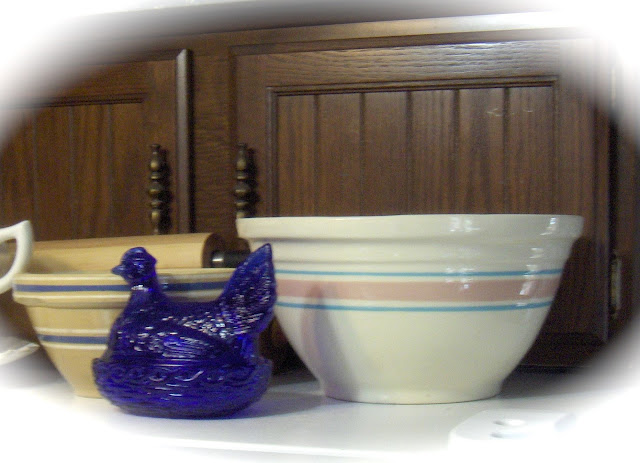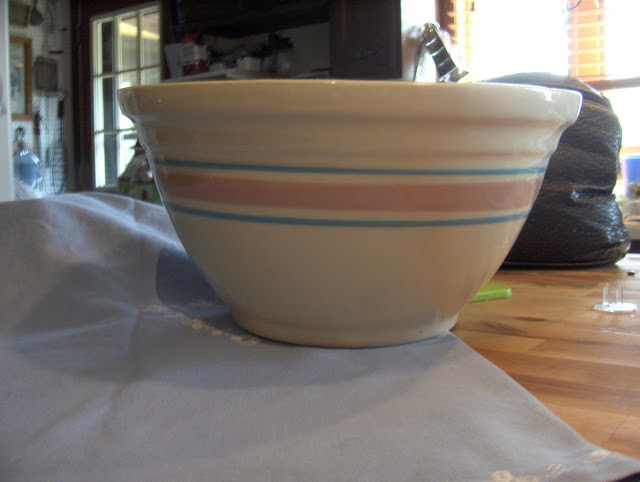First Good Morning, grab a cup, and sit for a chat.
The Chicago weather is finally starting to give us some cooler temperatures,
but with that is Rain, rain, Rain!~~~after Heat, heat Heat!
While it was so hot, I cleaned my kitchen (even the top of the FRIDGE) and thought about
what to share, as I was up there and it was all sparkling clean.
So here are OUR very OLD Grannys' bowls,
both my husband's and my Granny's are represented here.
 |
| oldnewgreenredo |
Normally two of these are on top of the double-oven stove, but I grouped them here for you.
I was a potter for thirty years so I'm going to chat about the origins of these bowls.
So you may learn more than you wanted to know.
 |
| oldnewgreenredo |
Beginning on the left is probably the OLDest bowl, (1870-1890) the brown one.
Of course this one has already wandered over to my soon-to-be Fall setting beginning
on the white cabinet from the cookbook move.
The top of the white cabinet's occupied with ripening tomatoes, just about the last though.
The rest of the tomatoes will become green tomato relish.
 |
| oldnewgreenredo |
This is hubby's great-grandmother's from a farm in Kewaunee, County in NE Wisconsin.
The classic shape is unmarked, and I would venture to say it's early Macomb pottery,
glazed with an Albany slip. The dark brown, Albany clay came from the Albany, NY area.
Those mills closed in the 1990's, but I still have a 50# stash in the basement.
Many of the brown topped jugs with the gray bottoms were made in the Macomb, Illinois area.
The bowl could also be Western, Monmouth, Buckeye or
any one of a number of the early potteries from that area. RedWing in Minnesota
also produced similar products with similar type clays and glaze mixtures.
 |
| oldnewgreenredo |
Unmarked, but notice the bare foot on the bottom of the bowl showing the gray stoneware clay, and the smear in the brown almost to bare on the side (the green is my reflection in the shiny brown glaze.
 |
| oldnewgreenredo |
 |
| oldnewgreenredo |
Salt-glazing occured when salts were thrown into the kiln at a high
temperature which vaporized landing on the exposed clay areas of the wares, creating a clear glaze of sodium (salt) silica (clay).
This was a cheap and easy method of glazing pottery,
as it could all be
done in one firing and with less labor.
The brown stoneware is a perfect REDO with the fall gourds and textures in it.
 |
| oldnewgreenredo |
Next the Blue rimmed creamware bowl at the top of the picture.
This is a standard 8 ovenware bowl, from the Ohio Valley according to the clay color. Potteries such as McCoy, Roseville, Brush and Watt potteries all used yellow/tan Ohio Valley clays. The upper Ohio Valley had over three hundred potteries during the 1800's and the lower Ohio Valley perhaps more. Utilitarian wares were clear glazed over colored slip (clay) decorations such as these blue and white stripes.
 |
| oldnewgreenredo |
The bottom of my great grandmother's bowl says Ovenware 8 Made in U.S.A.
Probably pre-1930, and maybe very early McCoy.
 |
| oldnewgreenredo |
The large mixing bowl on the right is my grandmother's mixing bowl and is most often attributed to McCoy pottery. It's about 12" across and is from the 1930's. The body is creamware, although I believe some lighter clay has been added to the Ohio yellow clay body.
It is definitely from the 1930s from the coloring on the stripes of pink and robin's-egg-blue.
 |
| oldnewgreenredo |
Nice large size perfect for mixing huge batters or kneading breads.
 |
| oldnewgreenredo |
You can see the script letters in 'Oven Ware' dating it later, and the 12 designating the size, also says Made in U.S.A. The color in this picture is a bit off, shows more gray than creme-yellow.
I remember my Gramma mixing up three poundcakes or
loaves of buttery bread at a time in this bowl.
Sadly it has the beginnings of a crack now---It's 80 some years old, so I only use it for display.
 |
| oldnewgreenredo |
Back to this bowl in the front, not sure who this belonged to. My mom picked up early American stoneware pottery: bowl, crocks, pitchers, salters, and jugs. This one is unglazed on the outside with molded impressions on the sides and bottom, and glazed on the inside with a white/cream glaze.
This bowl is about 6" across and a bit of a mystery.
 |
| oldnewgreenredo |
Despite all the molded information on the bottom of this bowl, 'Trade Mark Registered US Patent Office', I was unable to narrow down the maker. Potteries were allowed to trademark their wares by registering with the US Patent Office after 1842. From the flourish script style of this piece, I would place this late 19th century or early 20th.
 |
| oldnewgreenredo |
However the name is not clear, possibly Savillo or either ...avillo or ...aville,
...avitto, or ...avitte with a script first letter that is nearly bare, could be an H, S, G, D ???
the figure above could be an eagle or a top of a squash/pumpkin. A
worker was simply too enthusiastic
sponging the bottom and hid its source forever, unless someone can spot this.
Potteries came and went fast before the largest factories took over, as our country grew.
 |
| oldnewgreenredo |
On unmarked stoneware and creamware utility pieces, the most important step to finding out the maker is the clay color and texture. The type of glaze, shape and design will help to determine age. For instance gray and brown stoneware fell out of favor early in the 20th century,
when lighter bodied clays began to be used.
A source for basic identification is this link: American Pottery.
I hope you learned a little something NEW.
But, our OLD Grannys' bowls are simply, priceless.
Always, thanks for stopping by,
Sandi
I will party at the following Links:

